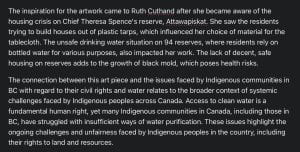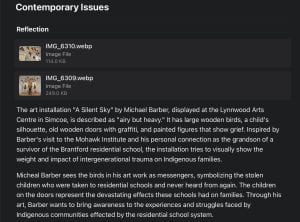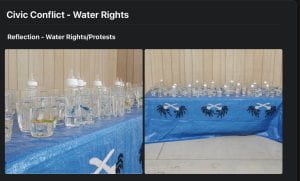Hello everyone and welcome back to another blog post. As the year is coming to an end, so are many projects. This post is going to be on the most recent project in Humanities. Lies and Incongruities. Throughout this post I will take you on the journey of this project. I will be sharing the ups and downs of this project, the messiness of it all, and what I learned. I hope you enjoy!
To start off this project, we did an I Am From poem. I really enjoyed this assignment. There were super loose constraints on how we could write it, and because of that, it was super fun and I got to use my creativity. At the time, I thought that this was going to be a super minor assignment but I actually ended up using parts of it in my final product. This was a super fun and creative way to start off the project.
Next up, we started gathering information. The end product was a collage that showed our understanding of Truth and Reconciliation. To be able to get to that point, we had to do a deep dive into what Truth and Reconciliation was and how it affects todays generation.
At the beginning of this project, I knew vaguely knew what Truth and Reconciliation was, but I didn’t really understand the full extent of it or why we do it. I mean, of course I knew generally why, and through this project, I’ve gained a deeper understanding of what it is. To me, Truth and Reconciliation is the processes that ties at address historical injustices, promote healing, and build a more inclusive society. After doing this project, I learned that it’s often used in the context of addressing genocide or other forms of systemic oppression and violence.
The Truth part in Truth and Reconciliation, to me, means uncovering and acknowledging the past and including the experiences and perspectives of minority groups who have been historically oppressed. It involves trying to find a understanding of the injustices that have been committed, often through the records of personal testimonies, historical research, and the examination of official records.
The Reconciliation part, to me, means focusing on building relationships and trying to have healing between different groups, specifically between the oppressors and the oppressed. It involves acknowledging the harm that was done, taking responsibility for past actions, and working towards a society where we know that this will never happen again. Reconciliation efforts may include things like money reparations, reforms, and the promotion of equal rights and opportunities.
Truth and Reconciliation processes are often led by the effected communities and involve storytelling, education, commemoration, and collective actions. It tires to create a shared understanding of history and a more just and inclusive society where the dignity and rights of all individuals are respected.
Through this project, I’ve learned so much about Truth and Reconciliation. Enough to be able to write all of that above. As I mentioned about, I went into the project not really knowing a whole lot about Truth and Reconciliation and now I feel like I could write a whole essay on it. Maybe not a whole essay but close.
Throughout this project, I did many analyses of different art pieces. Connecting them to certain issues. Below, you can check out some of the writing and I and the different art pieces. 👇




These art pieces that I found and reflected on would end up going into my final collage. In the end, I really enjoyed making my final product. It was a fun couple of days. I printed out all of the art pieces that I found, along with all of my writing and reflections and cut them all out and put them together. Originally, I was going to do just one piece of paper with this all on it. But after brain storming a little, I decided that I wanted to make it better. So I decided to make it an interactive piece. After making my main collage, I painted a black sheet of paper with red hands to symbolize the residential schools. Then, once you lift up the piece of paper, behind it is all of the learning and Truth and Reconciliation that I’ve done. I think that this added a big bit of depth and dimension to my piece. Below, you can check out my final product 👇


During this entire project, we were reading the Marrow Thieves book. The novel The Marrow Thieves by Cherie Dimaline reflects Canada both presently and historically in several ways. It sheds light on the experiences of Indigenous peoples and the impact of colonization, while also exploring modern issues such as environmental degradation and the struggle for cultural survival. The book presents these themes through a futuristic lens, set in a future where people hunt Indigenous peoples for there bone marrow, which holds the key to curing a pandemic disease.
The Marrow Thieves addresses contemporary environmental concerns, connecting them to the broader context of colonization. The book shows a future where the world is over taken by climate change, resulting in a less of resources. This reflects Canada’s current challenges with environmental issues such as deforestation, oil extraction, and the impact of industrial development on Indigenous lands. By intertwining these themes, the novel shows the connections of environmental justice and Indigenous rights.
Overall, I didn’t love the book. It started off OK but as it went on, it got less and less realistic and honestly kind of hard to follow. The ending was awful. It is a good book for school and learning about Indigenous peoples but personally I would not have read it in my spare time. You can click here to read all about my thoughts on the book.
As this post is coming to an end, I would just like to say that this has probably been one of my favourite projects all year. I’m really sad that my final product didn’t get to be in the exhibition because I worked really hard on it and I’m super proud of it. In the end though, I’m glad that I made it.
Best wishes,
Dana